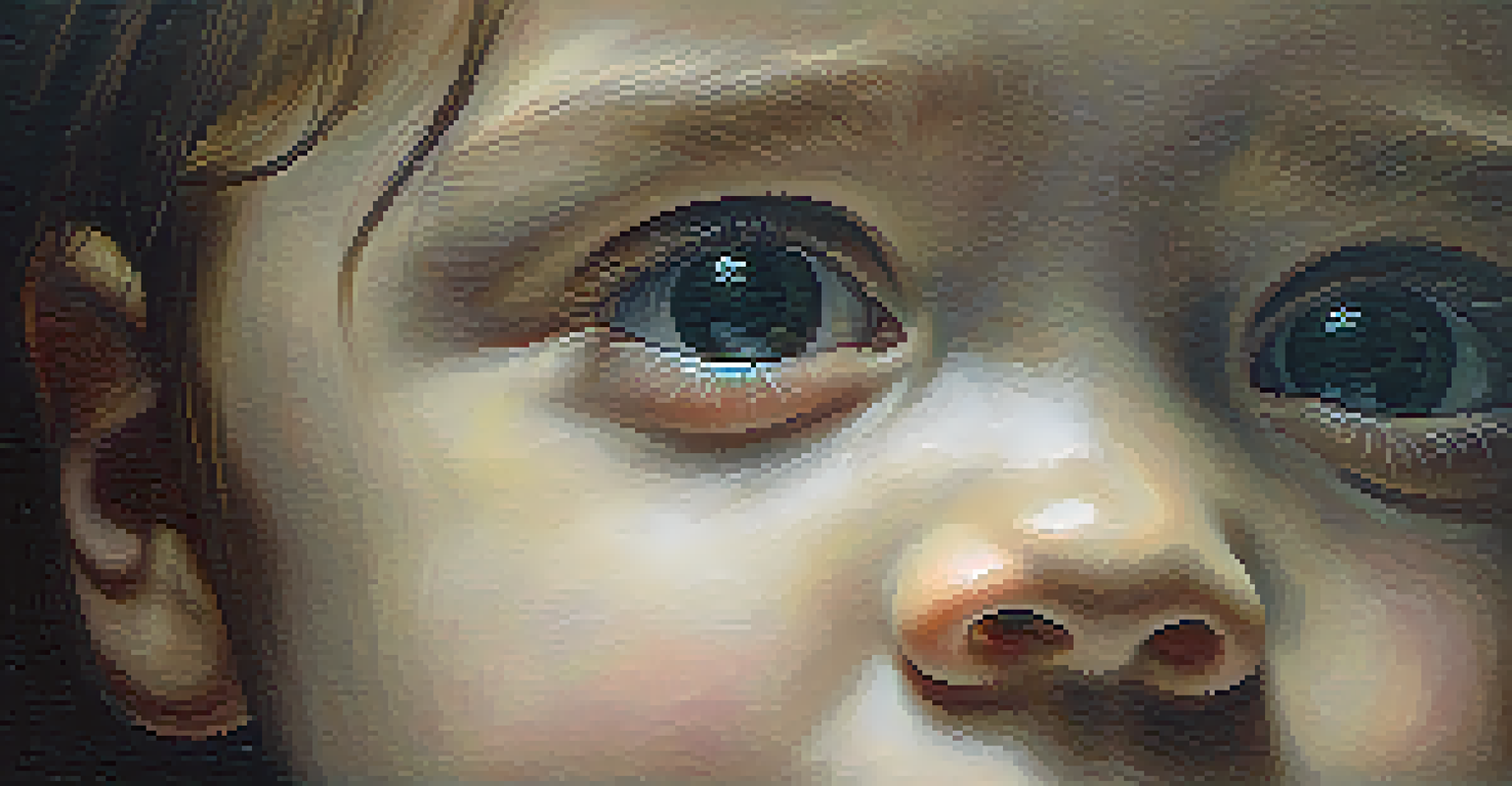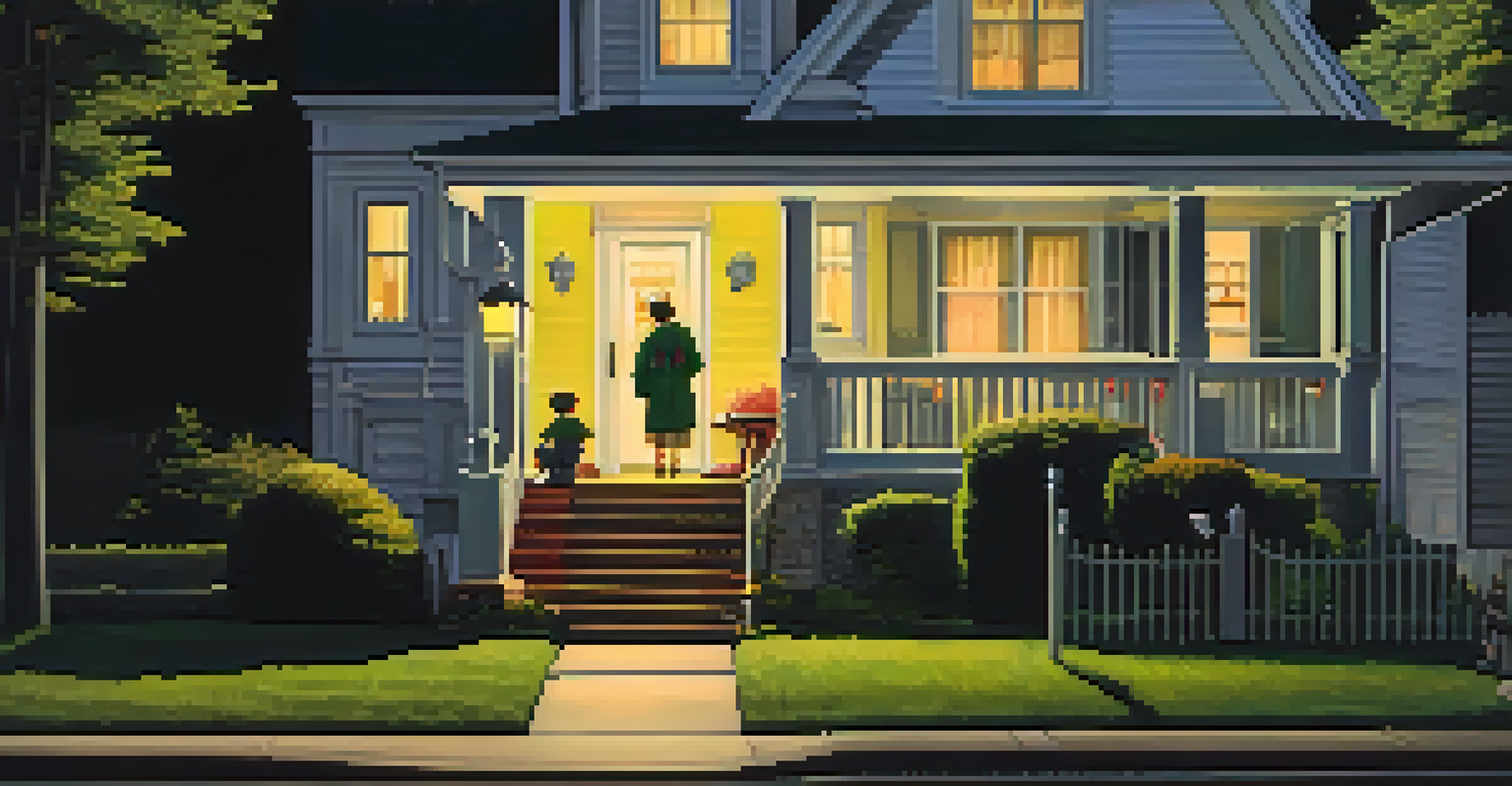The Mysterious Origins of the Legend of the Black Eyed Kids

The Enigmatic Emergence of Black Eyed Kids
The legend of the Black Eyed Kids (BEKs) first gained traction in the late 1990s. Reports began surfacing online, detailing encounters with children who had solid black eyes and unsettling behavior. This strange phenomenon quickly captured the imagination of both paranormal enthusiasts and curious onlookers alike. But what exactly sparked this eerie tale?
The unknown is what drives the imagination, and the fear of the unknown is what keeps us awake at night.
One of the earliest and most notable accounts comes from Texas journalist Brian Bethel, who shared his unsettling experience in 1996. Bethel described a chilling encounter in which two children approached him in a parking lot, asking for a ride home. Their pale skin and black eyes sent shivers down his spine, leading him to flee the scene. This story became the catalyst for countless others, as more people began to recount similar encounters.
As the legend spread, the internet played a crucial role in its propagation. Online forums and social media platforms allowed people to share their own spine-tingling stories, creating a sense of community around the phenomenon. This collective storytelling not only cemented the BEK legend in popular culture but also raised questions about the origins of these mysterious children.
Cultural Influences Shaping the BEK Narrative
The Black Eyed Kids legend draws on various cultural influences that enhance its eerie allure. Many believe that the BEKs embody societal fears, particularly around childhood innocence and the unknown. The idea of children asking for help, yet possessing a malevolent presence, resonates deeply with our innate desire to protect the vulnerable. This juxtaposition makes the tales both unsettling and compelling.

Moreover, the BEK phenomenon parallels other urban legends and folklore, like the infamous 'pale-faced child' archetype found in various cultures. For example, similar stories exist in Eastern European folklore, where spirits or supernatural beings often take on childlike appearances to lure unsuspecting victims. By drawing on these age-old narratives, the BEK legend taps into a rich tapestry of fear and fascination.
Origins of Black Eyed Kids Legend
The BEK legend emerged in the late 1990s, gaining attention through unsettling accounts shared online, notably Brian Bethel's chilling experience.
In addition to folklore, movies and pop culture have also played a significant role in shaping the BEK narrative. Films and television shows often portray children as harbingers of doom, further reinforcing the chilling nature of these encounters. This cultural backdrop not only adds depth to the legend but also invites exploration into our collective anxieties about childhood and the supernatural.
The Psychology Behind the Fear of Black Eyed Kids
The fear surrounding Black Eyed Kids can be linked to our psychological responses to the unknown. Human beings are wired to recognize and react to threats, and the concept of BEKs taps into our primal instincts. The uncanny resemblance to innocent children, combined with their unsettling appearance, triggers a deep-seated fear that something is amiss. This reaction is often amplified by the element of surprise in these encounters.
Urban legends reflect our deepest fears and anxieties, often revealing more about us than the stories themselves.
Additionally, the phenomenon plays into our cultural fascination with the supernatural. Stories of ghosts, spirits, and otherworldly beings have permeated our societies for centuries, and the BEK legend fits seamlessly into this narrative. The fear of the unknown often leads individuals to create explanations or narratives that help them process their experiences, even if those explanations are rooted in folklore or mythology.
Interestingly, some psychologists suggest that the allure of BEK stories may also stem from their ambiguity. The lack of concrete evidence surrounding these encounters allows for speculation and imagination, inviting individuals to ponder the possibilities. This open-ended nature of the BEK legend keeps it alive in conversations, as people continue to share and interpret their own experiences.
Notable Encounters with Black Eyed Kids
Throughout the years, many individuals have claimed to have had encounters with Black Eyed Kids. One particularly chilling story involves a woman who recounted a late-night visit from two children at her doorstep. They requested to come inside, insisting they were lost, but something about their presence felt deeply unsettling. The woman ultimately refused, leading her to wonder what might have happened if she had let them in.
Another account comes from a man who experienced a similar encounter while driving. He noticed two children standing by the side of the road, and as he slowed down to offer help, he was struck by their pitch-black eyes. His instinct told him to drive away, and he later reported feeling an overwhelming sense of dread. These accounts, while anecdotal, contribute to the growing legend of BEKs and their unnerving presence.
Cultural Influences on BEK Tales
The BEK narrative is shaped by societal fears, folklore, and pop culture, reflecting our anxieties surrounding childhood innocence and the supernatural.
These stories, whether rooted in reality or fiction, have sparked discussions about the nature of fear and the unknown. They serve as cautionary tales, warning us to be wary of what seems innocent on the surface. Each encounter adds a layer to the BEK mythos, ensuring that the legend remains a topic of intrigue and speculation.
The Impact of Social Media on BEK Stories
In today’s digital age, social media has become a powerful tool for sharing stories and experiences. The Black Eyed Kids legend has especially thrived in online communities, where people feel encouraged to share their own eerie encounters. Platforms like Reddit and Facebook have dedicated groups where enthusiasts discuss sightings, theories, and personal narratives related to BEKs. This increased accessibility has allowed the legend to evolve and expand rapidly.
Additionally, the visual nature of social media has enabled the sharing of artwork, memes, and videos related to BEKs. These creative interpretations further fuel the fascination surrounding the legend, as they bring the eerie tales to life in new and engaging ways. The blend of storytelling and visual elements captivates audiences, ensuring that the BEK phenomenon remains relevant in contemporary discourse.
However, the rise of social media also raises questions about the authenticity of these encounters. With the ability to easily fabricate stories online, distinguishing between genuine experiences and fictional narratives becomes increasingly challenging. This blurring of lines adds another layer of intrigue, inviting skepticism and curiosity about the truth behind the Black Eyed Kids.
Skepticism and Rational Explanations for BEK Sightings
While many are captivated by the legend of the Black Eyed Kids, skeptics often seek rational explanations for these sightings. Some suggest that the phenomenon could be a product of misperception or psychological factors, such as pareidolia—the tendency to see familiar patterns, like faces, in random stimuli. In dim lighting or stressful situations, it’s possible that individuals may misinterpret their surroundings, leading to the belief they've encountered BEKs.
Additionally, some critics argue that the proliferation of BEK stories can be attributed to the power of suggestion. Once the legend gained traction, it became easier for people to believe they had experienced something similar, even if their encounters were less sinister. This collective reinforcement can create a feedback loop, where new reports are influenced by existing narratives, perpetuating the legend.
Skepticism and Explanations for BEKs
Skeptics argue that BEK sightings may stem from psychological factors or the power of suggestion, yet the allure of these tales persists in popular culture.
Despite the skepticism, the allure of the BEK stories remains strong. People are drawn to the mystery and excitement surrounding the encounters, whether they believe in them or not. This dynamic interplay between belief and doubt enriches the legend, ensuring that it continues to captivate imaginations across generations.
The Ongoing Evolution of the BEK Legend
As with many urban legends, the tale of the Black Eyed Kids continues to evolve over time. New encounters, reinterpretations, and cultural influences contribute to a fluid narrative that keeps the legend alive. Each new story adds depth and nuance, allowing individuals to engage with the legend in unique ways, whether through storytelling, art, or online discussions.
Moreover, the rise of technology and digital media has created new avenues for exploring the BEK phenomenon. Podcasts, YouTube channels, and online documentaries delve into the lore, sparking interest and inviting listeners to share their own experiences. This multimedia approach has expanded the reach of the legend, ensuring it resonates with diverse audiences around the world.

Ultimately, the enduring fascination with Black Eyed Kids speaks to our innate curiosity about the unknown. As long as people continue to share their stories and explore the enigma, the legend will thrive, adapting to contemporary fears and cultural narratives. The BEK phenomenon reminds us that sometimes the most chilling tales are rooted in the very fabric of our imagination.